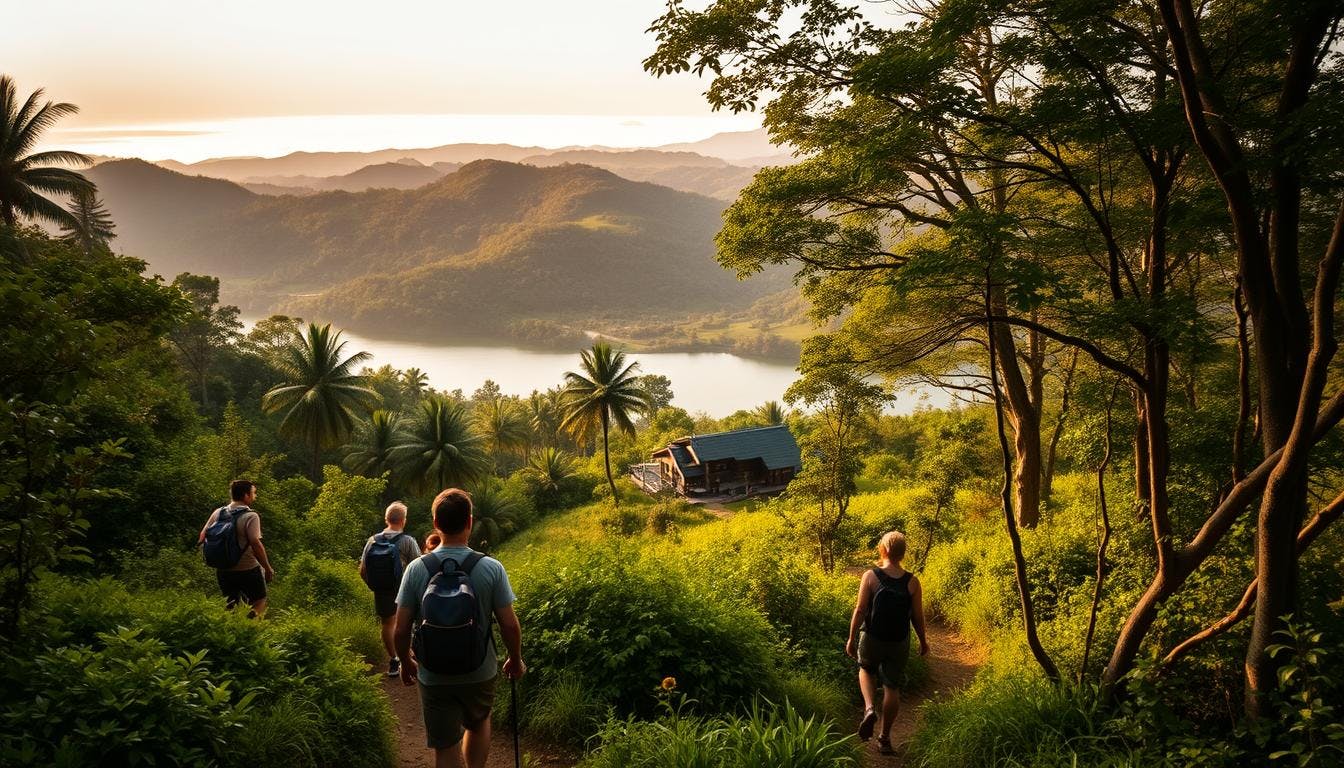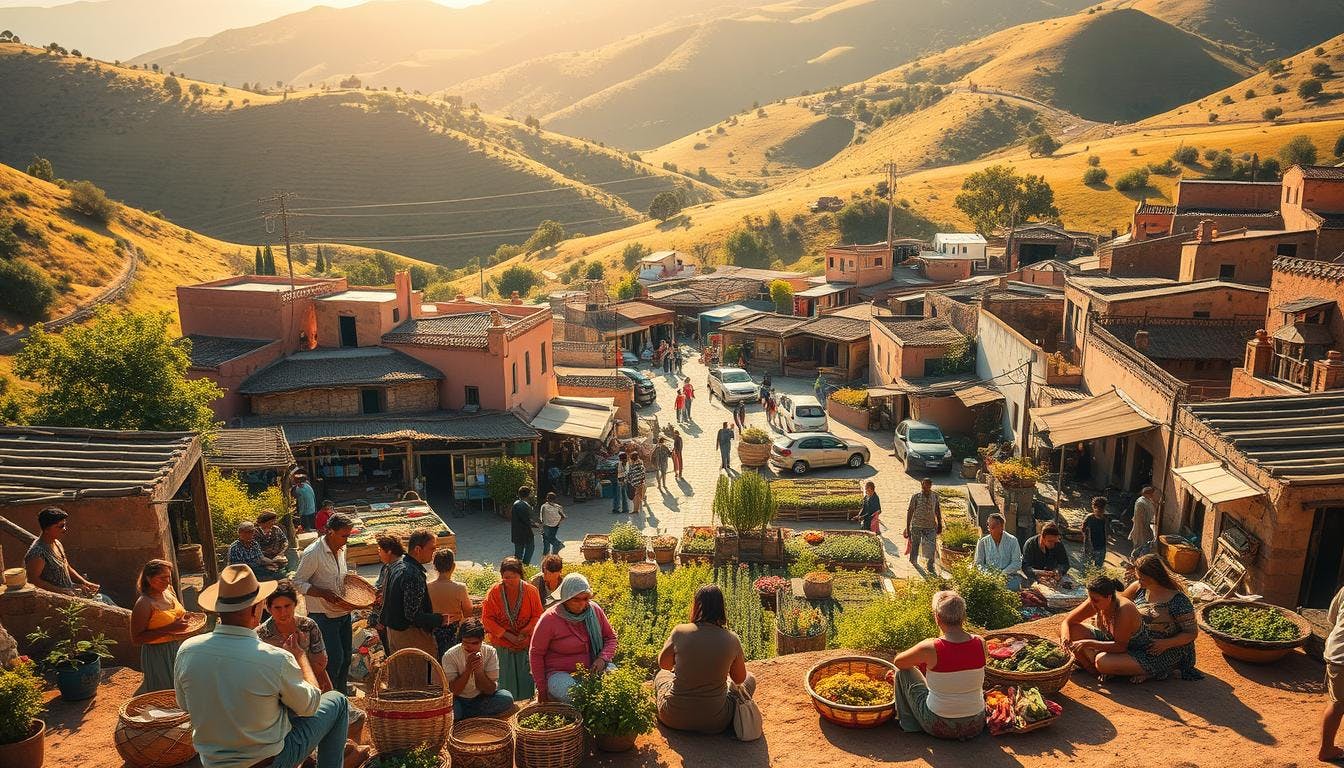Go the extra mile
Towards a cooler planet
Online travel agent platforms supporting local conservation projects
Today's tourism focuses on being green and caring for the planet. Companies aim to make money while also protecting the environment. This approach helps both the planet and local communities.
Intrepid Travel became carbon neutral in 2010. Since 2019, they cut CO2 emissions by 56% per person per day. G Adventures tracks the impact of local spending with the Ripple Score. Gondwana Eco Tours works with Cooler to lower industrial CO2 emissions.
These actions show how important conservation is in tourism. They also show how businesses can make a positive difference. By using these practices, companies can help ensure a better future for everyone.


Why ecologically conscious travel matters
Eco-conscious travel is now essential, not just a trend. Tourism is a big contributor to global CO2 emissions, making up 8% of them. This includes emissions from air travel, waste, water use, and habitat destruction. Plastic pollution is a major issue. Every year, 8 million metric tons of plastic enter the oceans. Coastal tourism is a big part of this problem, with 90% of plastic in ocean fish coming from these areas. This pollution harms marine life and disrupts ecosystems.
Uncontrolled tourism growth also harms habitats. It divides natural areas for infrastructure, threatening wildlife and biodiversity. For example, coral reefs have lost 30% of their health due to sunscreen chemicals, as the IUCN reports. Costa Rica is a good example with its 98% renewable energy for tourism. This shows sustainable tourism can thrive without harming the environment. It's a stark contrast to traditional tourism's heavy use of fossil fuels.
Water usage is another area where eco-tourism shines. Eco-tourism focuses on saving water, unlike traditional tourism. This approach reduces strain on local resources and supports long-term sustainability.
Carbon offset programs are also effective. Investing $100 can offset 1.2 tons of CO2, making it a practical way to reduce one’s carbon footprint. UNESCO’s 2025 sustainable tourism benchmarks encourage more environmentally friendly practices worldwide. These efforts highlight the importance of eco-conscious travel. By adopting sustainable tourism practices, both travelers and businesses can protect the planet while enjoying its beauty.
Benefits of using sustainable travel platforms
Sustainable travel platforms are changing how we see the world. They focus on eco-friendly ways that help both travelers and places they visit. By using them, people help the environment and local communities. Studies show that sustainable tours cut down waste by 62%. This is because of better waste handling. Also, carbon-neutral resorts see an 89% drop in respiratory problems near them.
There are also economic gains. For example, Follow Alice’s work in Tanzania created 214 jobs. G Adventures pays 40% more to local suppliers, boosting the local economy.
- B Corp-certified companies grow 15% faster than others.
- Eco-tours cost 12% more but make travelers 23% happier.
- GSTC standards help measure conservation success.
These efforts show the worth of sustainable travel platforms. They mix caring for the environment with growing the economy, benefiting everyone.


Intrepid travel: leading the way in carbon neutrality
Intrepid Travel is a leader in being carbon neutral for over a decade. This company shows its commitment to the environment through its actions and results. One big step is replacing 90% of short flights with land travel. This saves 437 tons of CO2 every year. It shows the company's effort to cut emissions and support green travel.
In 2023, Intrepid Travel started reporting on sustainability and finances together. This makes it clear how their work impacts the environment. It also sets a high standard for other travel companies. The company does more than just reduce emissions. In Q1 2024, they planted 12,000 trees in the Amazon. This helps with global reforestation and carbon capture.
- Carbon credit investments total $2.1M, going to wind farms in Vietnam.
- Emissions per passenger mile fell by 48% from 2019 to 2023.
- Cuba educational tours follow strict legal rules.
- The Intrepid Foundation gave $4.7M to 56 community projects worldwide.
These achievements show Intrepid Travel's leadership in sustainability. By focusing on results, they inspire change in the travel world.
Atlas obscura: unique cultural experiences with an ecological focus
Atlas Obscura mixes unique cultural experiences with low-impact practices. They make sure every trip is good for both travelers and the planet. They keep their groups small, with a 14-person limit, for more meaningful journeys. They offset 100% of carbon emissions through reforestation projects. This means every trip has a very small environmental impact. For example, their Central Asia road trip only emits 0.12 tons of CO2 per person.
In Scotland, Atlas Obscura uses 83% locally sourced food. This helps local farmers and cuts down on food's carbon footprint. In Brazil, they work with a sand spit village, investing $152K a year in the community. They plant mangroves at a 3:1 ratio to sequester carbon and protect coastlines. They also choose family-owned lodges for 92% of their accommodations.
Atlas Obscura works with Intrepid to train guides. This partnership improves the quality of their experiences while keeping them sustainable. They offer 147 unique itineraries across 54 countries, catering to all kinds of travelers.
Atlas Obscura is dedicated to combining culture with environmental care. By choosing their trips, travelers get to enjoy enriching experiences while supporting low-impact initiatives.


G adventures: connecting travelers with local communities
G Adventures has changed how travelers connect with destinations. They focus on making a positive impact on local communities and promoting sustainable tourism. The Ripple Score algorithm is a key feature. It shows how much money stays in the local economy, with an average of 78% going to local businesses. This means every trip directly benefits the places visited.
The Women With Wheels initiative is a great example of their commitment. It has employed 412 female drivers, helping women in male-dominated roles. This program supports economic independence and gender equality. In Peru, G Adventures trips have given $3.8M a year to the local economy. This money helps small businesses and improves community infrastructure. Their efforts show their dedication to lasting change.
- Tree planting metrics show 1.2M trees planted in 2023, aiding reforestation and carbon sequestration.
- Age-specific tours for the 18-30 demographic grew 27% year-over-year, reflecting increasing interest in sustainable travel.
- The Belize bike tour program boasts an 89% youth employment rate, providing opportunities for young locals.
- B Corp audit results exceeded the minimum score of 94/200, showcasing their commitment to ethical practices.
G Adventures makes sure every trip is good for both travelers and the communities they visit. By focusing on sustainability and empowerment, they set a high standard for responsible tourism.
Gondwana ecological-tours: small-group adventures with a purpose
Gondwana Ecological Tours combines adventure with caring for the environment. Since 2021, they've been 100% carbon neutral. They also donate $287K to local NGOs each year to help make a difference. Working with Cooler, they've retired 4,200 pollution permits in 2023. This big step helps reduce harm to our planet. Their Rwanda trip donates $58 per traveler to gorilla conservation, helping protect wildlife. They keep groups small, with a max of eight people. This reduces trail erosion by 63%. It also makes the trip better for everyone. Plus, 94% of their accommodations are locally owned, helping the local economy.
In Alaska, they follow strict whale-watching rules, keeping a safe distance of 300 meters. They're open about their donations, listing 23 organizations they support. In Costa Rica, they plant 18 acres of trees every year, helping the environment. Gondwana Eco Tours shows how small groups can make a big difference. They focus on sustainability and helping communities, setting a good example for travel.
Follow Alice: empowering local guides and communities
Follow Alice is known for helping local communities through tourism. They've been in Tanzania for ten years, keeping 70% of trip fees local. This has a lasting effect on the areas they visit. They pay their guides 38% more than the average, ensuring fair wages. This not only helps the guides but also improves the travel experience for everyone. In Zanzibar, they work with 12 family-owned guesthouses. These places offer real experiences and support local businesses. Their Kilimanjaro operations have a 94% local staff ratio, boosting community involvement.
They check accommodations with a 14-point checklist for sustainability. Their Sweden kayaking trip uses 100% renewable energy, showing their commitment to being ecologically conscious. They're also transparent about their impact, with 89% of clients happy with their reports. These reports show how tourism helps communities, like educating 214 children every year.
Follow Alice combines meaningful experiences with a focus on sustainability. They empower local guides and communities, setting a high standard for responsible tourism.
Adventure alternative: combining adventure with social responsibility
Adventure Alternative has been leading in combining adventure with social responsibility for 30 years. They reinvest 89% of their profits in local businesses, making a positive impact. This sets a high standard for sustainable travel. Through the Moving Mountains Trust, they've given $1.7M since 1991. This money supports projects like building schools in Nepal with trekker donations. It shows their dedication to lasting change.
They offer Kilimanjaro expeditions for ages 14 to 78. Their carbon calculator is accurate, tracking environmental impact well. In Borneo, they follow strict wildlife rules, keeping a safe distance from primates. Keeping staff happy is a big deal, with 61% of them working here for over a decade. This makes the travel experience better for everyone. In Kenya, they've built 17 wells, helping 23,000 people get clean water.
Adventure Alternative cares a lot about helping communities and the planet. They make sure every trip helps both the traveler and the place they visit. This sets a high standard for ecologically compatible travel.
Take the next step towards sustainable travel
Choosing low-impact travel can really help the planet. Research shows 73% of travelers are willing to pay more for low-impact tours. To pick the right options, use a 7-point checklist.
These low-impact tours might need 6-9 months to book, but they're worth it. They cost a bit more, but they make a big difference. Tools like the Ripple Score help you see how your money helps.
Make a change today by choosing low-impact travel. Even small steps can make a big difference. Start your journey to more responsible travel now.
17 South Street
Auckland 1010
New Zealand
info@carbonclick.com- -
- X
Sign up. Be inspired. Get clicking.
Subscribe now to stay up to date with CarbonClick, carbon offsetting and climate action.
By signing up you agree to our Privacy Policy.


